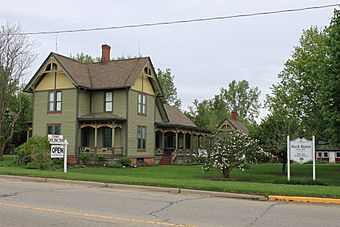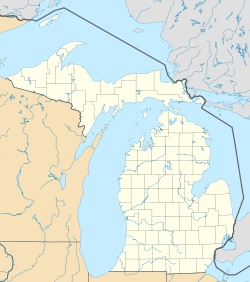Friend–Hack House facts for kids
Quick facts for kids |
|
|
Friend–Hack House
|
|
 |
|
| Location | 775 County St., Milan, Michigan |
|---|---|
| Area | 1.3 acres (0.53 ha) |
| Built | 1888 |
| Architectural style | Stick / Eastlake |
| NRHP reference No. | 91000441 |
| Added to NRHP | April 25, 1991 |
The Friend–Hack House, often called the Hack House, is a historic home located at 775 County Street in Milan, Michigan. It was built in 1888 and is now a museum that shows what life was like in the past. It was added to the National Register of Historic Places in 1991 because of its special history and architecture.
Today, the Hack House Museum is a fun place to visit. It is open on Sundays from 1:00 PM to 4:00 PM between May and late November. The museum sometimes holds special events, like an Ice Cream Social in the summer. In the fall, you can even pick out pumpkins and use an old-fashioned corn sheller in the barn.
Contents
The Story of the Hack House
The history of this house is connected to a surprising story from the 1880s. It involves a new invention, a lot of money, and a young woman named Olive Friend.
A Mysterious Invention
In the mid-1880s, a man named Professor Henry Friend arrived in New York City. He claimed he had invented a special machine. This machine supposedly used electricity to make sugar pure. In 1884, he started the Electric Sugar Refining Company.
Many people were excited about this idea. They bought parts of the company, called shares, hoping it would be successful. The price of these shares went up quickly. But Professor Friend had health problems and passed away in 1888. After he died, his young wife, Olive, and her parents took over the company.
Olive Builds a House in Milan
Olive was originally from Milan, Michigan. Using money from the company, she bought 80 acres of land from her uncle, William Hack. On this land, she had this beautiful house built for herself and her son.
After her husband's death, Olive and her son moved back to Milan. But soon, other leaders of the Electric Sugar Refining Company became suspicious. They started to look into the company's factory in Brooklyn.
In early 1889, they made a shocking discovery. Professor Friend's amazing invention was not real. The machine never existed, and the whole process was a trick. Olive and her parents had to return to New York to help with the investigation. In the end, Olive and her mother were allowed to go free, but her father was held responsible for the company's problems.
The House Gets a New Family
Olive returned to her new house in Milan. She soon remarried, moved to Detroit, and sold the house to her uncle, William Henry Hack. She passed away in 1902.
William and his wife Mary Hack moved into the house. In 1901, their son James and his wife Daisy also moved in. James and Daisy lived in the house for over 70 years, until 1973.
After that, a company called Owens-Illinois bought the house. In 1980, the company kindly donated the house to the Milan Area Historical Society. The society turned it into the Hack House Museum to share its history with everyone.
What the House Looks Like
The Friend–Hack House is a great example of a building style called Stick / Eastlake. This style was popular in the late 1800s and is known for its fancy wooden decorations.
The house is a large, two-story building with a pointed, gabled roof. It's covered in wooden boards called clapboard. You can see decorative wooden beams, called kingposts, under the peaks of the roof.
Large, covered porches, or verandahs, wrap around parts of the house. There are also several smaller buildings on the property. These include a wash house, an outhouse, a carriage house where horses and buggies were kept, and a chicken coop.



